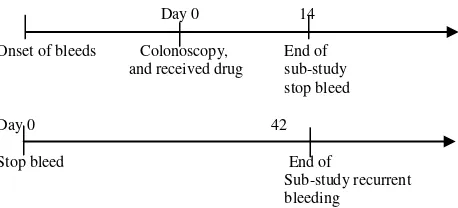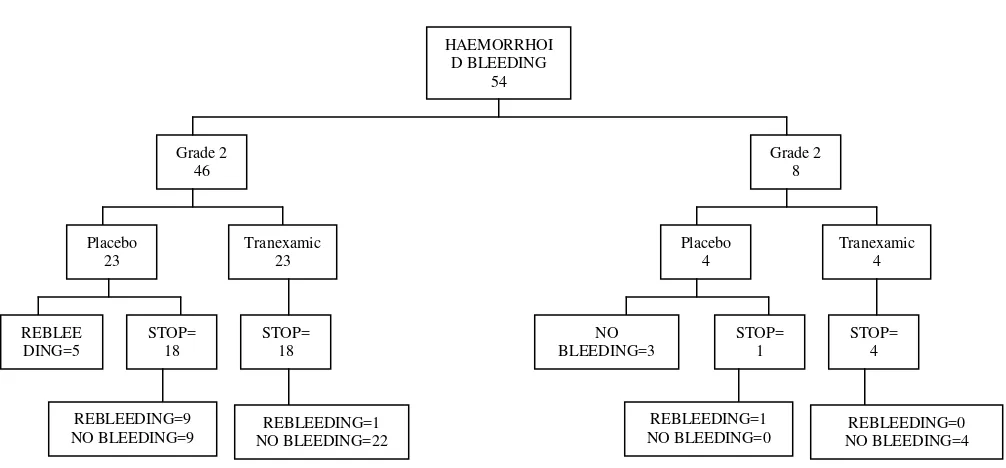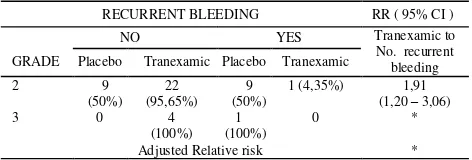Division of Gastroenterology, Department of Internal Medicne, Faculty of Medicine, University of Indonesia/Dr. Cipto Mangunkusumo Hospital, Jakarta, Indonesia
Double blind, placebo-controlled trial of Tranexamic acid on recent internal
haemorrhoid bleeding
A. Aziz Rani
Abstrak
Telah dilakukan penelitian samar ganda acak untuk menilai manfaat pemberian Asam Traneksamat pada 54 penderita hemoroid interna yang baru berdarah. Umur, kelamin, berat badan, tinggi badan, beratnya hemoroid serta lamanya onset perdarahan telah dibuat sebanding pada kedua kelompok. Efek hemostatik berupa berhentinya perdarahan didapatkan pada 100% (23/23) kelompok Asam Traneksamat pada hemoroid grade 2 sementara hanya 78.26% (18/23) pada kelompok plasebo. Setelah observasi 3 hari perdarahan berhenti lebih awal pada kelompok Asam Traneksamat dan secara statistik bermakna. Sejak hari ke empat kedua kelompok berbeda dalam hal perdarahan ulang. Pada kelompok plasebo rerata median perdarahan ulang terjadi setelah 36 hari, sementara kelompok Asam Traneksamat tidak pernah mencapai nilai median tertentu sampai akhir observasi.Kesimpulan: Asam Traneksamat efektif untuk menghentikan perdarahan pada hemoroid berdarah, dan mencegah perdarahan ulang. (Med J Indones 2002; 11: 215-21)
Abstract
A double blind randomized placebo controlled trial was conducted to evaluate the efficacy of Tranexamic acid in 54 patients with recent haemorrhoid bleeding. Age, gender, body weight, height, grade of haemorrhoid, time of onset of recent bleeding were comparable between two groups. Analysis of haemostatic effect or cessation of bleeding as an immediate outcome of this study revealed that in the grade 2 patients, 23/23 (100%) of tranexamic group and 18/23(78.26%) of placebo group the bleeding stopped . After 3 days of observation, there was statistically significant differences for the rapidity of cessation of bleeding as well as at the end of observation. Bleeding stopped earlier in the tranexamic group with a median of 4 days (3-5 days), compared to placeo which showed a median of 11(9.55-12.45) days. Analysis of recurrent bleeding in this study revealed that in the placebo group 9/18(50%) of grade 2 patients and all of grade 3 (100%)patients suffered from recurrent bleeding. Since day 4, both group have significant different time for recurrent bleeding and at the end of observation, cumulative probability of absence of bleeding between the two groups were significantly different. Median til cessation of bleeding in the placebo group was 36 days, and the tranexamic group never reaches the median until the end of observation. Conclusion: tranexamic acid was an effective drug to stop haemorrhoid bleeding and prevent further recurrent bleeding. (Med J Indones 2002; 11: 215-21)
Keywords: Tranexamic acid, haemorrhoid bleeding, haemostatic effect, recurrent bleeding.
Almost everyone suffers from haemorrhoid at some time in their lives. The symptoms include bleeding, prolapsing tissue, fullness after defecation, and pain. Bleeding can mimick or mask the diagnosis of cancer and must be thoroughly evaluated. In most cases, however swift, simple, and effective treatment can be given in an outpatient clinic or a health center.1-4
Bright red rectal bleeding, unmixed with stool, is usually the first symptom of haemorrhoid and when it did not stop, most common patients to go to hospital.
allow immediate definitive surgery to be deferred to a time more convenient to patient and surgeon. As a prevention for short and long term recurrent bleeding, tranexamic acid as a plasmin inhibitor generated from plasminogen may have an effective secondary haemostasis ability. Antifibrinolytic therapy compared to placebo showed a significant reduction in mean blood and significant change in mean reduction of blood loss. This objective improvement was not mirrored by a patient perceived improvement in monthly menstrual blood loss. There were no significant differences in the frequency of reported gastrointestinal side effects with tranexamic acid when compared to either NSAIDs, oral luteal phase progestagens or ethamsylate, when these treatments were used for heavy menstrual bleeding.8 However the efficacy of tranexamic acid to stop haemorrhoid bleeding was not fully elaborated. The aims of this double blind randomized placebo controlled trial were to investigate the efficacy of tranexamic acid to stop recent haemorrhoid bleeding and prevent further recurrent bleeding.
MATERIAL AND METHODS
Patients having bright red rectal bleeding which did not stop until diagnosed by colonoscopy to ensure that bleeding were only from grade 2 or 3 of internal haemorrhoid, and normal haemostatic test by bleeding time, prothrombin time, activated partial thrombo-plastin time, fibrinogen activity, and thrombocyte count. Patients who have hepatic cirrhosis, past history of deep-vein thrombosis, stroke, and ischaemic heart disease were excluded. Sample size are 23 patients for each grade and each drug type, based on two tailed 5% confidence limit, 80% powered, and both drugs type of each grade estimating have median survivor. Period of study was July 1999 until August 2000. Randomized allocation for each stratum of internal haemorrhoid was graded by personal computer. Blinding of tranexamic acid 500 mg and placebo by repackaging in the same color of capsule and then coding each with Drug A and Drug B by Pharmacists. Studies are divided in 2 sub-studies; (a) time of cessation of recent bleeding, and (b) time to recurrent bleeding since cessation of recent bleeding. Dates of onset of bleeding are date of day first blood presence on stool in recent bleeding, Date of cessation of recent bleeding are date of day first on last 2 days with no blood on stool. Date of recurrent bleeding are date of day first of blood presence on stool after more than 3 days with no recent bleeding.
Drug were given for 10 days 3 times daily 1 capsule, and period of the study are shown in Figure 1.
Statistical analysis. Equality of both groups for continuous data with normal distributions were analyzed by independent t, and continuous data with free distributions were analyzed by Mann-Whitney U. Equality of both groups for categorical data analyzed by chi-square or Fisher’s exact. Equality of both groups for categorical time dependent data, log-rank and Wilcoxon was applied in Kaplan-Meier survival analysis.
Day 0 14
Onset of bleeds Colonoscopy, End of and received drug sub-study
stop bleed
Day 0 42
Stop bleed End of
Sub-study recurrent bleeding
Figure 1. Period of Sub-study cessation of bleeding and sub study recurrent bleeding.
RESULTS
From July 1999 to August 2000, 54 haemorrhoid patients who were eligible and recruited to this study, 46 patients with grade 2, and 8 patients with grade 3. We finished sample recruitment of grade 3 patients because time end limit of the study has completed.
Sample characteristics
Time of onset of bleeding to diagnosis were minimum 4 days and maximum 35 days with a median of 8 days, and mode on day 5. Interquartile ranges have 6 to 11,25 days.
Baseline characteristics are shown in Table 1. Age, gender, bodyweight, body height, grade of haemorrhoid, and time of onset of bleeding to give drugs did not differ between subject who had received placebo and those who had received tranexamic acid.
Summaries of this study’s outcome are shown on
haemorrhoid bleeding, 9/18 (50%) of grade 2 patients and all of grade 3 patients have recurrent bleeding until end of the day of observation.
Table 1. The characteristics of patients
Placebo Tranexamic P
Age
Cessation of bleeding of recent haemorrhoid bleeding
Survival analysis table on haemorrhoid bleeding patients who received placebo and who received tranexamic acid is shown in Figure 3. Since first 3
days, both groups showed significant difference in time to cessation of bleeding, and also the end of observation during drug consumption, cumulative probability of still bleeding in both group showed a significant difference. Mean and median of still bleeding of both group-receiving tranexamic acid stratified by grade of internal haemorrhoid are shown in Table 2. Comparison of duration of bleeding distributions by grade of haemorrhoid for both placebo and tranexamic acid at the end of observation are shown in Table 3.
Table 2. Still bleeding analysis for placebo and tranexamic acid stratified by grade
0,1
. . .
0 1 2 3 4 5 6 7 8 9 10 11 12 13 14 Cessation of bleeding (Day)
Figure 3. Time to cessation of bleeding curve of patients who received placebo and tranexamic acid
. . .
Figure 4. Duration to time of recurrent bleeding of patients receiving placebo and tranexamic acid. 0,4
0,3 0,5 0,6 0,7 0,8 0,9
0,2 1
0
Placebo Tranexamic
C
umulati
ve
durat
ion of
b
lee
ding
G
ra
d
e
2
0,9 1
0,8
0,6
0,5
0,4 0,7
C
umulati
ve
durat
ion of
n
o blee
ding
G
ra
d
e
2
0,3
0,1
Placebo Tranexamic 0,2
Table 3. Comparison of duration of bleeding according to grade of haemorrhoid for both placebo and tranexamic acid at the end of observation
Log rank Wilcoxon patents who received placebo and tranexamic acid showed significant difference.
Table 4. Distribution of cessation of bleeding by type of drugs and their relative risk received placebo and tranexamic acid according to internal haemorrhoid grade to cessation of recent bleeding is shown in Table 5. Both groups of patient who received placebo and tranexamic acid showed significant difference. Adjusted relative risk to cessation of bleeding for tranexamic acid by grade has nearly equal to unadjusted relative risk. This is due to lack of number of grade 3 cases.
Table 5. Equality of Stop bleeding distributions for both drugs adjusted by grade
STOP BLEEDING RR (95% CI )
YES NO Tranexamic to
stop recent
Placebo Tranexamic Placebo Tranexamic bleeding
GRADE
Time to recurrent bleeding after cessation of haemorrhoid bleeding
Survival (bleeding free period) analysis table on still stop recent haemorrhoid bleeding patients who received placebo and who received tranexamic acid is shown in Figure 4. Since first 4 days both group have significant different time to recurrent bleeding, and also to the end of observation after cessation of bleeding, cumulative probability of bleeding free period of both group have significant difference. Mean and median of bleeding free period of patients on both groups received placebo and tranexamic acid stratified by grade of internal haemorrhoid are shown in Table 6. Equality of bleeding free period distributions stratified by grade of haemorrhoid for both placebo and tranexamic acid at the end of observation are shown in Table 7.
Table 6. Bleeding free period analysis for placebo and tranexamic acid by grade
Placebo Tranexamic Mean of bleeding free period*
Grade 2 21,89 Median of bleeding free period
Grade 2 36,00 ( - ) -
Grade 3 3,00 ( - ) -
* Limited to 36 days.
Table 7. Equality of Still Stop bleeds stratification by grade of haemorrhoid for both placebo and tranexamic acid on the end of observation.
Table 8. Distribution of recurrent bleeding and risk by type of
Analysis comparing both group patients who received placebo and Tranexamic acid adjusted by stratum of internal haemorrhoid grade to recurrent bleeding after recent stop bleeds is shown in Table 9. On both group of patients who received placebo and Tranexamic acid have significant difference. Adjusted relative risk to stills tops bleeding for tranexamic acid by grade cannot be calculated, there are needed more subject stop bleeding grade 3 on sub-study recurrent bleeding to gives no one probability are zero ( 0 ) for stratum study analysis.
Table 9. Equality of Still stop bleeds distribution for both groups adjusted by grade.
RECURRENT BLEEDING RR ( 95% CI )
NO YES Tranexamic to No. recurrent bleeding GRADE Placebo Tranexamic Placebo Tranexamic
2 9
Adjusted Relative risk *
* Cannot be calculated because in grade 3 PB/Yes = 0 and PA/NO = 0, Relative risk calculation needed no one probability are zero
DISCUSSION
Rectal bleeding as an acute manifestation of haemorrhoidal disease is a common problem in general practice with quite divergent in clinical presentation, from minor blood dripping to massive lower gastro intestinal bleeding with hypovolemic shock. For the patients interest it is a very troublesome symptoms and worried some for more serious diseases such as colon cancer or inflammatory bowel disease. Patients mostly concern to have bleeding stop immediately, and to prevent recurrent bleeding. It is very important to exclude more serious diseases as mentioned above by doing
rectosigmoidos-copy or total colonosrectosigmoidos-copy in particular high-risk patients or old age group.
This is a double blind placebo controlled trial without any difference of sample characteristics between two groups. Sub analysis of grade two haemorrhoid period after the bleeding stop, cumulative probability of free of bleeding significantly better in the Tranexamic group than placebo. After 3 days significantly more patients in Tranexamic group had stop bleeding compare to placebo (p 0.00042).Analysis of recurrent bleeding between two groups revealed that tranexamic acid significantly better than placebo for the prevention of bleeding. The relative risk for rebleeding in the placebo group was 14.2 compare to Tranexamic acid and relative risk for free of rebleeding in Tranexamic acid group was 2.03 compare to placebo, both were statistically significant different.
Tranexamic acid is an antifibrinolytic agent, which is very active in the site of bleeding on the whole gastrointestinal mucosa. Some study revealed the high fibrinolytic activity secondary to bleeding on the gastrointestinal mucosa, and Tranexamic acid will stabilize the fibrin and stop further bleeding.
This double blind placebo controlled study proved the effectiveness of this drug on acute or recent Haemorrhoidal bleeding and prevent further rebleeding episode during follow up. Tranexamic acid could play some important role in the management of acute manifestation of haemorrhoidal disease, in com-bination with anti phlogiston and anti-inflammatory drugs.
In conclusion Tranexamic acid is highly effective to stop recent haemorrhoidal bleeding and prevent further recurrent bleeding.
CONCLUSION
Acknowledgments
We wish to thank Daiichi Pharmaceutical for facilitating and supporting this study.
REFERENCES
1. Zainea G, Randall G, Norman DA, Pfenninger JL. Office treatment of haemorrhoids. In: Pfenninger JL, Fowler GC, eds. Procedures for primary care physicians. St. Louis: Mosby, 1994:929-53
2. Pfenninger JL, Surrell J. Non surgical treatment options for internal haemorrhoids. Am Fam Physician. 1995; 52: 821-37 3. Bleday R, Pena JP, Rothenberger DA, Goldberg SM, Buls
JG. Symptomatic haemorrhoids: current incident and
complications of operative therapy. Dis Colon Rectum 1992;35:477-81
4. Yang R, Migikovsky B, Peicher G, Laine L. Randomized, prospective trial of direct current versus bipolar electrocoagulation for bleeding internal haemorrhoids. Gastrointest Endosc 1993;39:766-9
5. Schussman LC, Lutz LJ. Out patient management of haemorrhoids. Prim Care 1986;13:527-41
6. Hancock BD. ABC of colorectal diseases. Haemorrhoids. BMJ 1992;304:1042-4
7. Hardwick RH, Durdey P. Should rubber band ligation of haemorrhoids be performed at the initial outpatient visit? Ann R Coll Surg Enland. 1994;76:185-7



